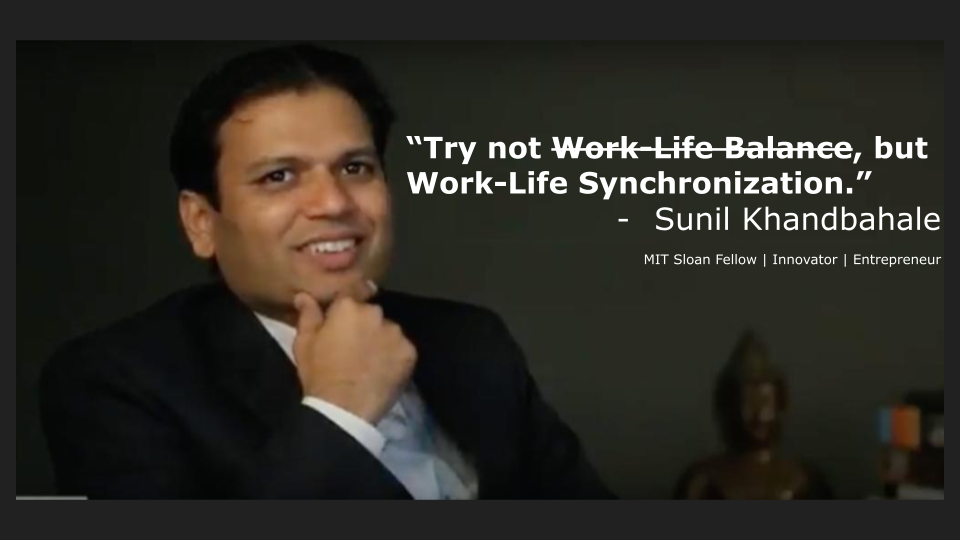Try not Work-Life Balance, but Work-Life Synchronisation – Sunil Khandbahale

The term ‘Balance’ separates the ‘Work’ and ‘Life’. However, term ‘Synchronisation’ unites them both together. Let’s understand the concepts of “Work-Life Synchronisation” with real-world situations;
Situation 1: Maria, a working parent, practices work-life synchronization in her daily life. One evening, while preparing dinner with her family, Maria receives an urgent work email. Instead of feeling stressed about disrupting family time, Maria openly discusses the situation with her spouse and children. Together, they decide to address the work matter as a family, with Maria quickly responding to the email while her spouse and children continue cooking. As they work together in the kitchen, they share stories, laughter, and support, seamlessly blending work and family time. By integrating work responsibilities with family activities and fostering open communication, Maria and her family experience a sense of unity and cooperation, demonstrating the effectiveness of work-life synchronisation in creating a balanced and fulfilling home life.
Situation 2: James, a manager in a fast-paced corporate environment, embodies the principles of work-life synchronization at work. One morning, while leading a team meeting, James receives an unexpected call from his child’s school. Without skipping a beat, James informs his team about the situation and delegates tasks accordingly, ensuring that the meeting continues smoothly while he steps out to address the family matter. Upon his return, James openly shares the experience with his team, emphasizing the importance of flexibility and understanding in balancing professional and personal commitments. By integrating his family responsibilities with his role as a manager and fostering a supportive work environment, James showcases the benefits of work-life synchronisation in promoting employee well-being and productivity.
In above two situations of professional life, the work-life synchronisation is depicted as a more holistic and integrated approach to managing both work and personal life. By breaking down the barriers between work and home and fostering open communication and collaboration, individuals can achieve a greater sense of harmony and fulfilment in all aspects of their lives. Let’s pause and think of an entrepreneurial life situation.
Situation 3: Meet Alex, a successful entrepreneur who values both his business and his family. One weekend, Alex has an important business meeting in a nearby city, and he’s planning to travel with his colleague, Sarah. Instead of treating it solely as a business trip, Alex decides to turn it into a family outing. He invites Sarah and her family to join him for the trip, suggesting they combine the business meeting with a weekend getaway for everyone. Together, they arrange a productive meeting during the weekdays, followed by a relaxing weekend exploring new places and enjoying quality time with their families. By integrating work commitments with family activities, Alex not only strengthens his relationships with his colleague and their families but also demonstrates his commitment to work-life synchronisation as a guiding principle in his entrepreneurial journey.
Situation 4: James, an innovative entrepreneur, believes in fostering a culture of work-life synchronization within his startup. One day, James and his team are faced with a tight deadline for a new project. Instead of resorting to long hours at the office, James suggests a different approach. He encourages his team to bring their families to the office for a special “Family Day” where they can work together on the project while enjoying time with their loved ones. James arranges fun activities and snacks for the families, creating a relaxed and supportive atmosphere conducive to creativity and productivity. By merging work commitments with family presence in the workplace, James not only meets the project deadline but also reinforces the importance of work-life synchronisation in achieving success as an entrepreneur.
In above situations, the entrepreneurs demonstrate how integrating work commitments with family activities and fostering a supportive work environment can lead to greater productivity, creativity, and overall well-being for themselves, their colleagues, and their families. By prioritising work-life synchronisation over traditional work routines for a holistic approach to managing work and personal life.
We are living in a complex and competitive world. We need to learn the art of living meaningful life to its potential. Just like in above situations, we can practice to synch life and work and yet achieve both without compromising any of those. However, views may defer on focus and perfection, and that’s OK! Let’s have a broader conversation on such topics. This has reminded me of a very eye opening story on prioritising work over life choice.
Story 1: Once upon a time, there was a hardworking father who wanted nothing but the best for his family. He worked tirelessly, even taking on extra jobs, to provide them with a comfortable life. However, he kept his struggles a secret, wanting his family to believe they were living a life of luxury.
Despite his efforts, his family grew accustomed to the lavish lifestyle, and the father felt compelled to work even harder to maintain it. Eventually, he made the difficult decision to work abroad, sending money home regularly but missing out on precious family moments for nearly a decade.
When he finally returned home, exhausted but hopeful for quality family time, he found his family had changed. His children didn’t recognize him, and his wife was preoccupied with her own interests. Feeling lost and alone, he realized he had sacrificed too much in pursuit of material wealth.
In a heart-to-heart conversation with his family, he shared the truth about his struggles and regrets. His family, initially upset and distant, gradually came to understand his sacrifices and the importance of true communication and connection.
With the help of a supportive friend, they reconciled and pledged to prioritize each other over material possessions. They embraced the concept of work-life synchronization, where work and family life are intertwined, fostering understanding, compassion, and meaningful relationships.
It beautifully illustrates the consequences of prioritizing work over family and the importance of open communication and transparency in maintaining meaningful relationships. The father’s journey highlights the pitfalls of striving for a work-life balance that ultimately leads to isolation and disconnection from loved ones.
In contrast, the concept of work-life synchronization, as exemplified by the father’s friend who comes to enlighten his family, emphasizes the integration of work and family life. It encourages individuals to share their struggles and successes openly, fostering understanding, compassion, and support within the family unit. By embracing work-life synchronisation, families can navigate challenges together, strengthen their bonds, and ultimately lead more fulfilling lives.
The story underscores the message conveyed in the quote – “Try not Work-Life Balance, but Work-Life Synchronisation”, advocating for a holistic approach to life where work and family are not seen as separate entities but rather as interconnected aspects that contribute to overall well-being. Through true communication and a commitment to living authentically, individuals can cultivate harmonious relationships both at home and in the workplace, ultimately leading to greater happiness and fulfilment.
The stories are often proved an effective tools to express the concepts and thoughts. I love stories. Let me take a liberty by sharing you one more touching story while we are together in the thought process of work-life synchronisation.
Story 2: There was a little boy named Timmy, who was very excited about his birthday. He really wanted his dad, Mr. Smith, to be there for his special day. But Mr. Smith was always busy with work, and Timmy felt sad.
One day, Timmy asked his dad, “Dad, how much money do you make in an hour?” Mr. Smith wondered why Timmy was asking, so he said, “Well, I make $20 an hour, Timmy. Why do you ask?”
Timmy smiled and said, “I’ve been saving up my allowance, and I have $20. Can you spend an hour with me on my birthday? That’ll be my present.”
Mr. Smith’s heart melted at his son’s request. He realized how important it was to spend time with Timmy. So, on Timmy’s birthday, Mr. Smith took an hour off work to be with his son.
During that hour, Timmy and Mr. Smith went for a walk and talked about everything. Timmy felt so happy to have his dad with him.
Later, Mr. Smith had an idea. He decided to take Timmy to his workplace, the car company where he worked. He introduced Timmy to his colleagues and boss, who welcomed Timmy warmly. They even celebrated Timmy’s birthday together.
After a quick tour of the workplace, Mr. Smith finished his work tasks quickly so he could spend more time with Timmy. In the evening, he invited his boss and colleagues to Timmy’s birthday party at their home.
Timmy was overjoyed to have his dad and his work friends celebrate his birthday together. And Mr. Smith realized that work-life synchronization was not just about balancing work and family, but also about integrating them to create meaningful moments together.
From that day on, Mr. Smith made sure to prioritize spending time with Timmy, realizing that those moments were the most precious gifts of all.
This story highlights the importance of work-life synchronization through the touching experience of a father and son, showing how integrating work and family can lead to meaningful connections and happy memories.
Disclaimer: The characters and events depicted in the narrative are purely fictional. Any resemblance to real persons, living or deceased, is purely coincidental.

